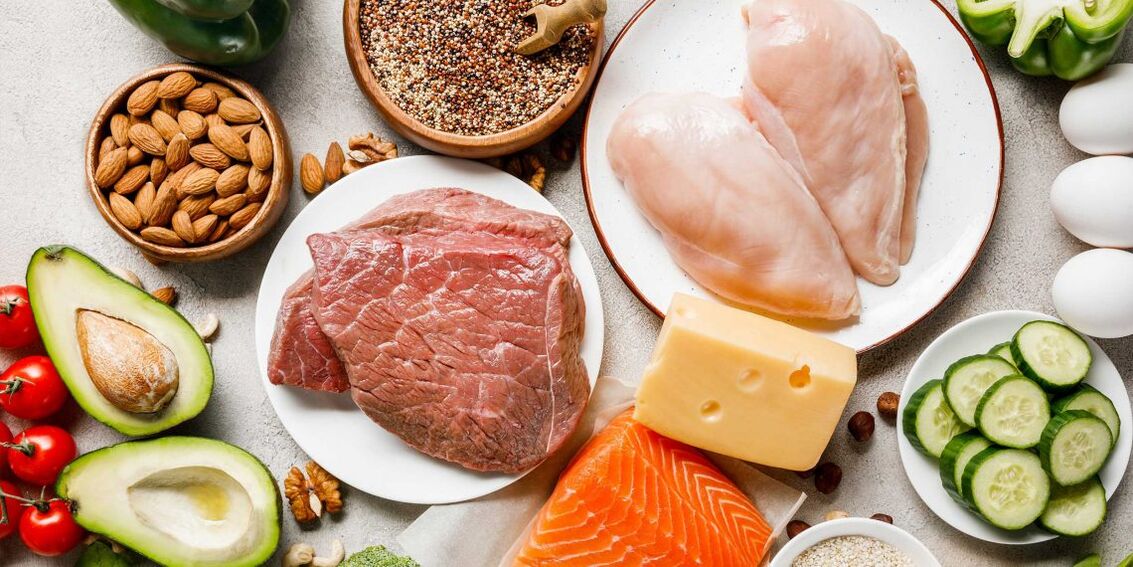On a ketogenic diet, you can eat a lot of fatty foods and exclude all flour and sweetness. 60-70% of all calories should come from fat, 20-30% protein and 10% carbohydrates. Pay special attention to carbohydrates: You can’t eat more than 50 grams per day regardless of your weight and calorie consumption.

Fat can be obtained from vegetable oils and lard, meat and fish, cheese, sour cream, ugly yogurt, eggs and nuts. Most of these products also contain enough protein to achieve a daily rate of -1. 5–2 g per kilogram of body weight. You only get carbohydrates from vegetables, unsweetened fruits and berries to get enough vitamins. No familiar side dishes: cereals, pasta, potatoes. Candy and alcohol are absolutely forbidden.
So, you lose weight on a keto diet
Carbohydrates are the main fuel for the human body. When you consume less than 50 grams of carbohydrates per day, their reserves in the body will be exhausted after a day and the body begins to split fat and use fatty acids for energy production. However, not all organs can eat fat: the brain only needs glucose or some alternative.
To obtain glucose, the liver produces ketone bodies from fatty acids: acetate, which then becomes beta-hydroxy hydrogen, and nourishes the brain, heart, kidneys, muscles and other tissues. As a product of exchange, acetone is formed, so its concentration in the urine increases and breath becomes sweet.
Usually, ketones are continuously produced in the body, and the concentration in the blood is about 0. 2-0. 5 mmol/l. Food ketosis occurs when they grow to 0. 5-5 mmol/L at levels. Unlike ketoacidosis, it is not dangerous to health, in which ketoacidosis, the concentration of ketobody increases to 10–25 mmol/l. This condition may die from starvation.
Although you are not reducing the calorie content in your diet, in a state of ketosis, the body begins to get rid of fat reserves. Since the glucose level in the blood is zero, the production of the hormone insulin is inhibited, and adipogenesis is the deposition of fat in the reserve. Additionally, Keto Diet reduces your appetite, which can also help you lose weight: You won't break if you don't think about calories.
How much does it cost to throw a ketogenic diet
Everything is individual. In a review of six studies dedicated to the ketogenic diet, participants lost from 3. 2 kg to 12 kg in six months. If we get an average of all results in the review, it will be about 6 kg in 6 months.
Who should try a keto diet
Despite the complexity and strict restrictions of day one, the ketogenic diet is perfect for some. Worth trying:
- Those who love meat. If you can't do without it and fat products, and your diet is indifferent to candy and bread.
- Those who want to lose weight without losing muscle mass. A keto diet helps lower fat, including viscera, while retaining dry muscle mass. In addition, diet does not affect power metrics, so it is perfect for athletes who exercise strength. Although it will not work to increase muscle.
- People with diabetes in the first and second categories. Due to the failure of insulin production, diabetics are forced to take the hormone to avoid a sharp jump in blood sugar. The keto diet greatly reduces its levels. However, before moving to Keto, you must consult the attending physician for diet.
- Those who want to maintain brain health. Keto diet has a positive impact on psychological and emotional health, protects the brain from neurodegenerative diseases and helps with migraines and epilepsy.
- Those who want to reduce the risk of atherosclerosis. The diet reduces the amount of "bad" cholesterol and fat in the blood and increases the percentage of "good".
- Those who fear the cancer diet limit the reactive form of oxygen and reduce inflammation, which is often associated with oncology.
- Runners and athletes. If you are an athlete with endurance cycle exercise, a keto diet can improve your metrics.

Who can't sit on a ketogenic diet
This diet is taboo:
- In people with kidney and liver diseases, fatty acid oxidation.
- Those who work in team sports, athletes and runners. If the course involves prolonged stays in anaerobic mode, the keto diet will reduce your metrics.
- A person with fragile bones. Possible side effects of diet include changes in bone mineral composition, which may lead to an increased risk of fractures.
Is it difficult to follow a ketogenic diet
The keto diet is not the lightest diet, especially at first. When your body begins to experience glucose, the symptoms of ketogripp may show: nausea, vomiting, headache, fatigue, dizziness, constipation and insomnia. They last 2-3 days to several weeks. In this case, you can't consume more carbohydrates to relieve the condition.
If you break, your body will receive the desired glucose and you will come out of ketosis and must be repeated once. This is a difficulty in maintaining your diet. On the other hand, here’s its advantage: you know that after the crash, you’ll have to do unpleasant adaptability again, so you’ll stick with it.
How to sit on a keto diet
Personal coaches and nutritionists recommend dividing periods in diet into several stages and following certain rules.
1. Preliminary preparation (2-4 weeks)
Enter 40-80 grams of coconut oil into your diet to provide triglycerides to the human body. They are quickly absorbed, not deposited in fat, and processed in the liver of the ketone bodies. You can eat food supplements with keto in powder form, rather than oils.
Reduce the amount of carbohydrates to 100 grams per day. So you won't get into ketosis, but you have to learn how to have fewer foods containing carbohydrates on your own.
2. Entering ketosis (4 days)
Day 1. Skip breakfast and lunch and starve all day until evening. During dinner, no more than 200-300 kcal, 10-15 grams of protein and 15-30 grams of fat should be added. No carbohydrates.
Day 2. Eat breakfast and lunch, eat the same portion for dinner - from the usual food. No carbohydrates.
Day 3. For breakfast and lunch, you can eat from regular food and cook. Still no carbohydrates.
Day 4. Eat the usual portions and you can open up granular vegetables and unsweetened fruits.
At this stage of training, it is best to replace long walks. This will burn glucose and help get into ketosis faster. If on a walk, it seems that the strength ends in the legs, it is a good sign: the glycogen reserves are almost exhausted.
Continue taking coconut oil or carbohydrate powder, add vitamins and beverages with electrolytes.
3. Ketone adaptation (2-4 weeks)
It will take several weeks to fully adapt to your diet. Currently, you need carbohydrate support within 30 grams per day - if you are engaged, you need 20 g - if not. Remember that the energy levels will be slightly lower at the beginning. This is normal and gradually passes through. At this stage, carbohydrate powder is no longer required.

How much can you sit on a keto diet and how to go out to avoid weight recovery
The keto genetic diet can last 3-4 weeks to one year. It doesn't make sense to stick to a diet for less than three weeks, because during this time your body will adapt through Keto and you will only start to gain all the benefits of this diet. As for the terms over a year, there isn't enough scientific data to judge this, but eating like this is a bad idea. First, a prolonged keto diet increases the risk of liver obesity, hypoproteinemia, kidneys, and vitamins and mineral deficiencies. Secondly, giving up one of the macro elements will not affect the life of life in the best way. An analysis of data from more than 150, 000 people shows that overdose and lack of carbohydrates can increase the risk of death in the long run. The longest person's diet consists of 50-55% carbohydrates.
Good news: It’s not difficult to maintain weight after eating.
With the calorie content cut in a regular diet, the amount of auxin-Henger hormone increases because a person wants to eat all the time, break down, and once it is done, he can eat food. The study shows that using ketogenic will not happen, thus making your weight easier. Another study demonstrated that resting for half a year on the 40-day diet on the Mediterranean diet resulted in stable weight loss without further habits.
The Mediterranean diet is an excellent choice after keto. It also contains a lot of fats you will get used to, and carbohydrates are consumed from useful sources: whole grain products, vegetables and fruits. Unlike the keto diet, the Mediterranean can last a lifetime without health risks.















